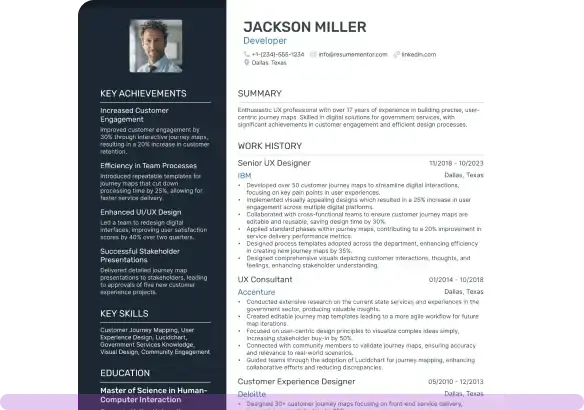Clerical Resume Examples

Mar 26, 2025
|
12 min read
Master the art of crafting a clerical resume that stands out, ensuring your skills and experience are front and center. Avoid paper jams in your job hunt and stack up against the competition with our easy tips.
Rated by 348 people
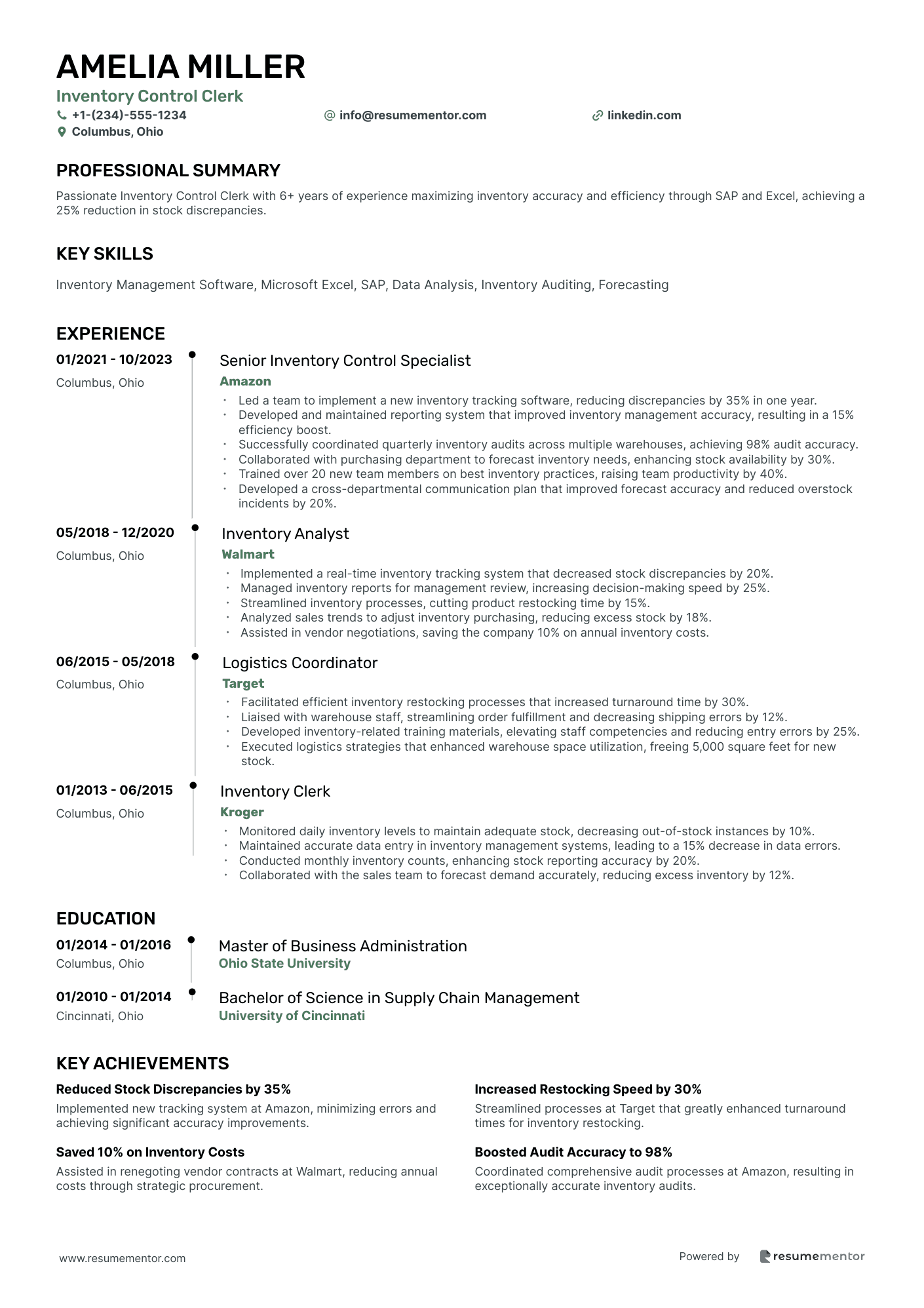
Inventory Control Clerk
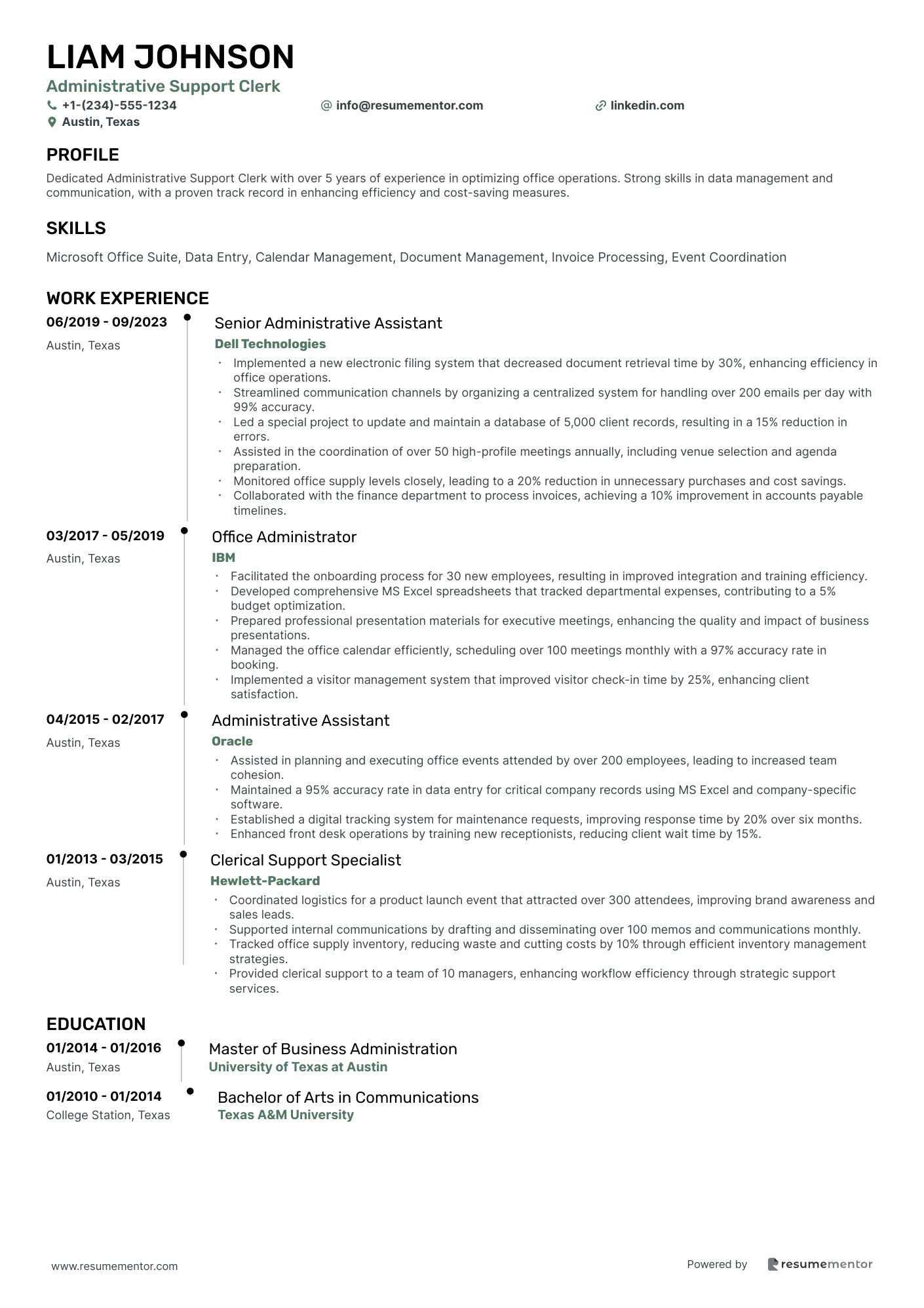
Administrative Support Clerk
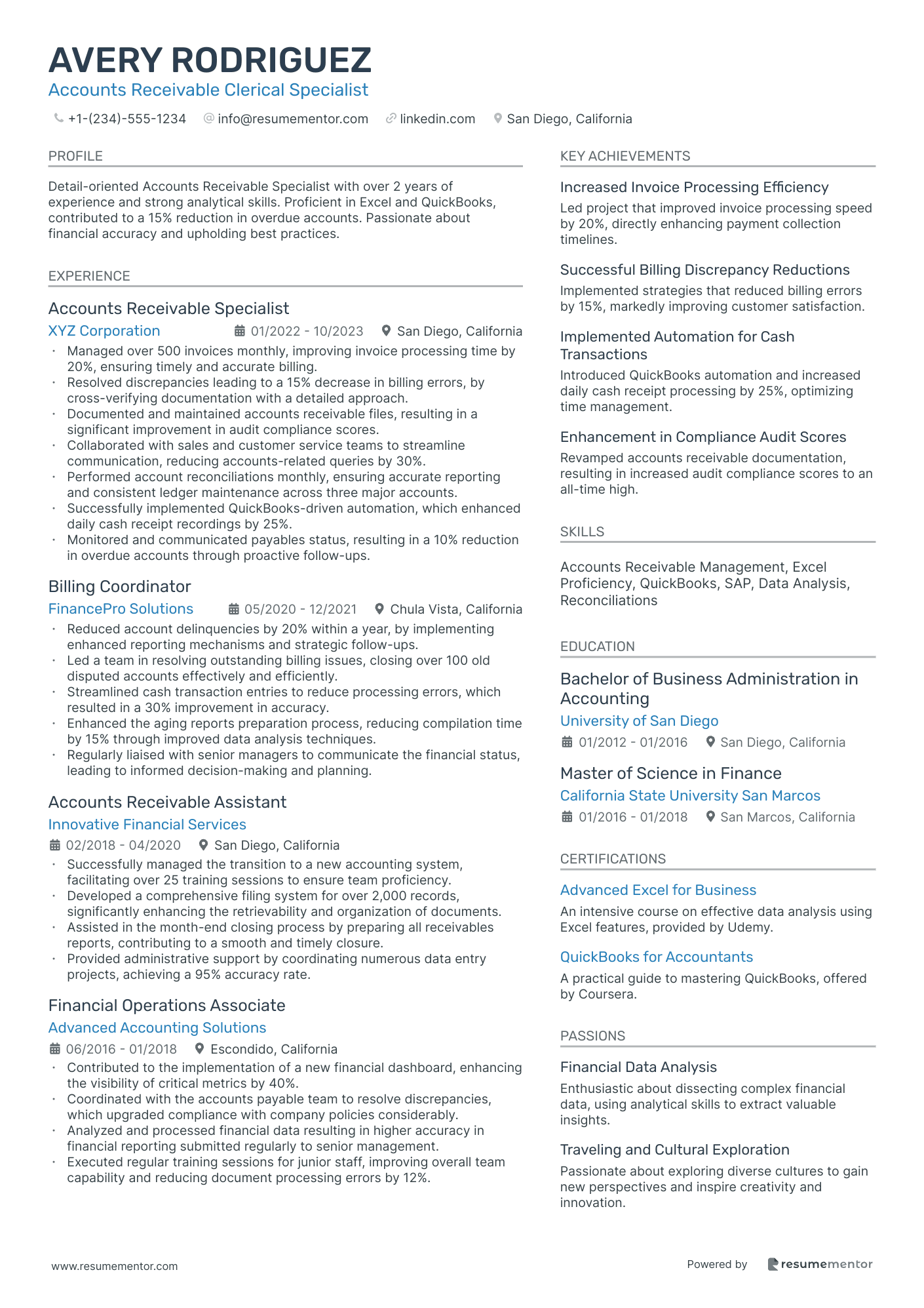
Accounts Receivable Clerical Specialist
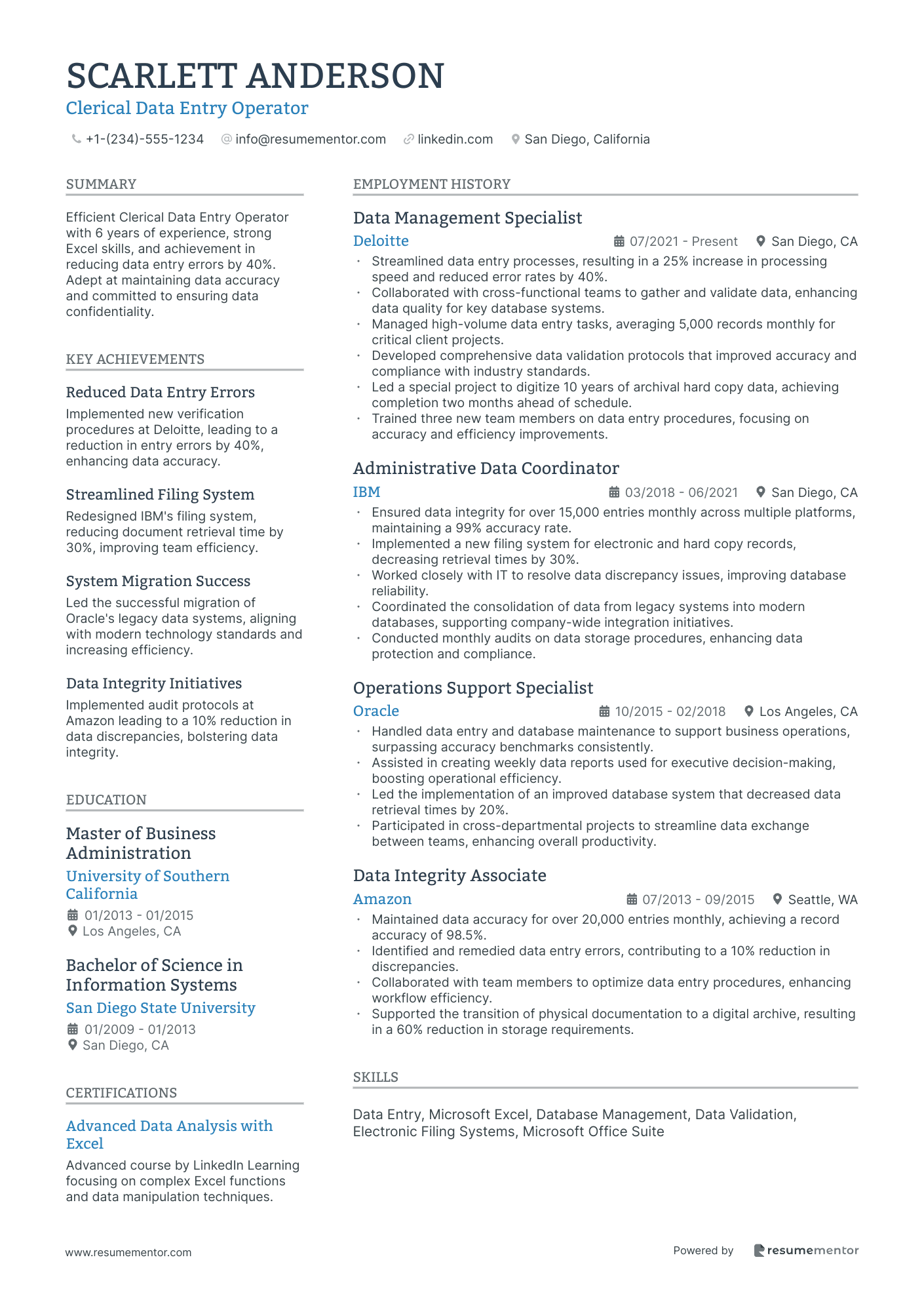
Clerical Data Entry Operator
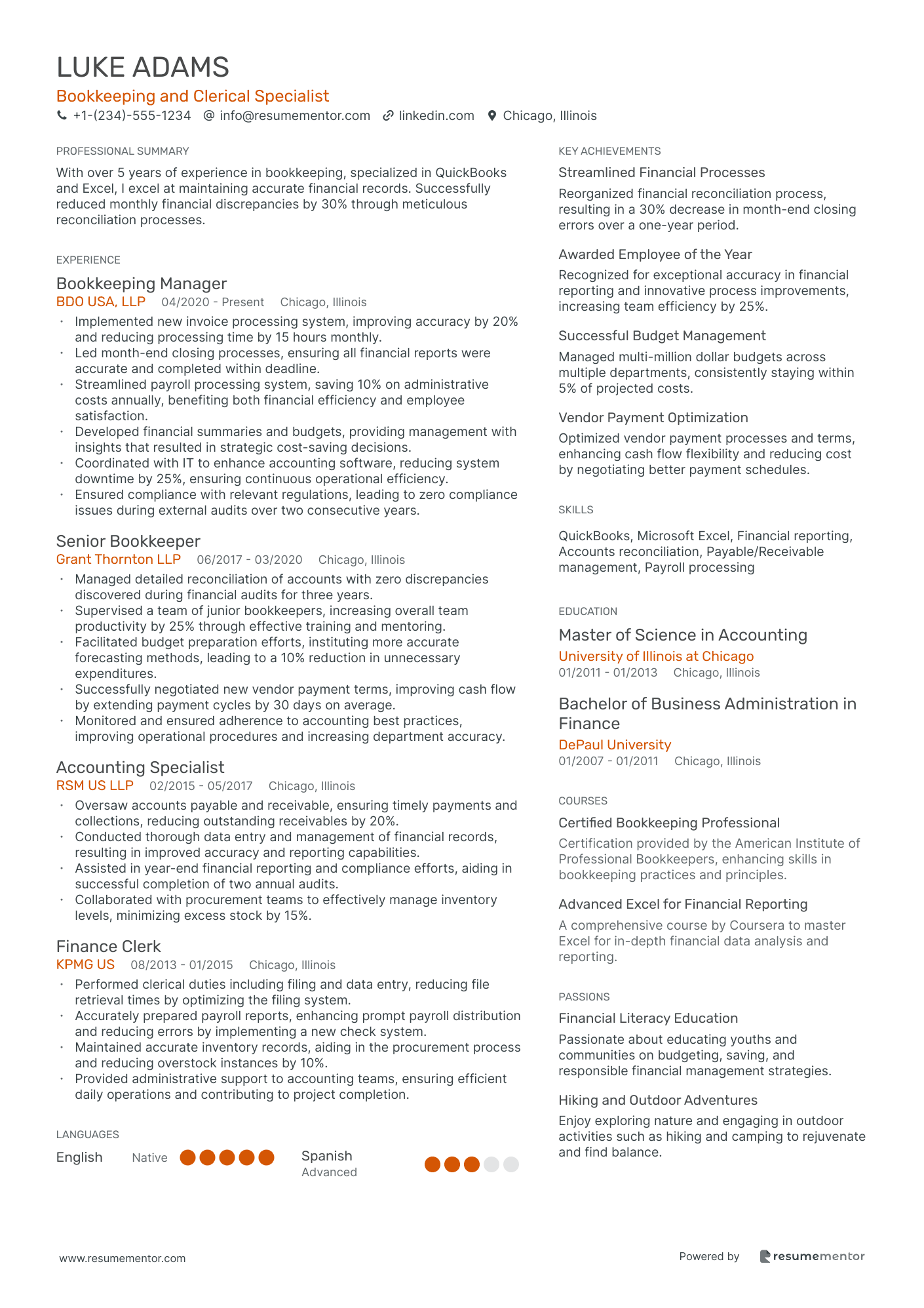
Bookkeeping and Clerical Specialist
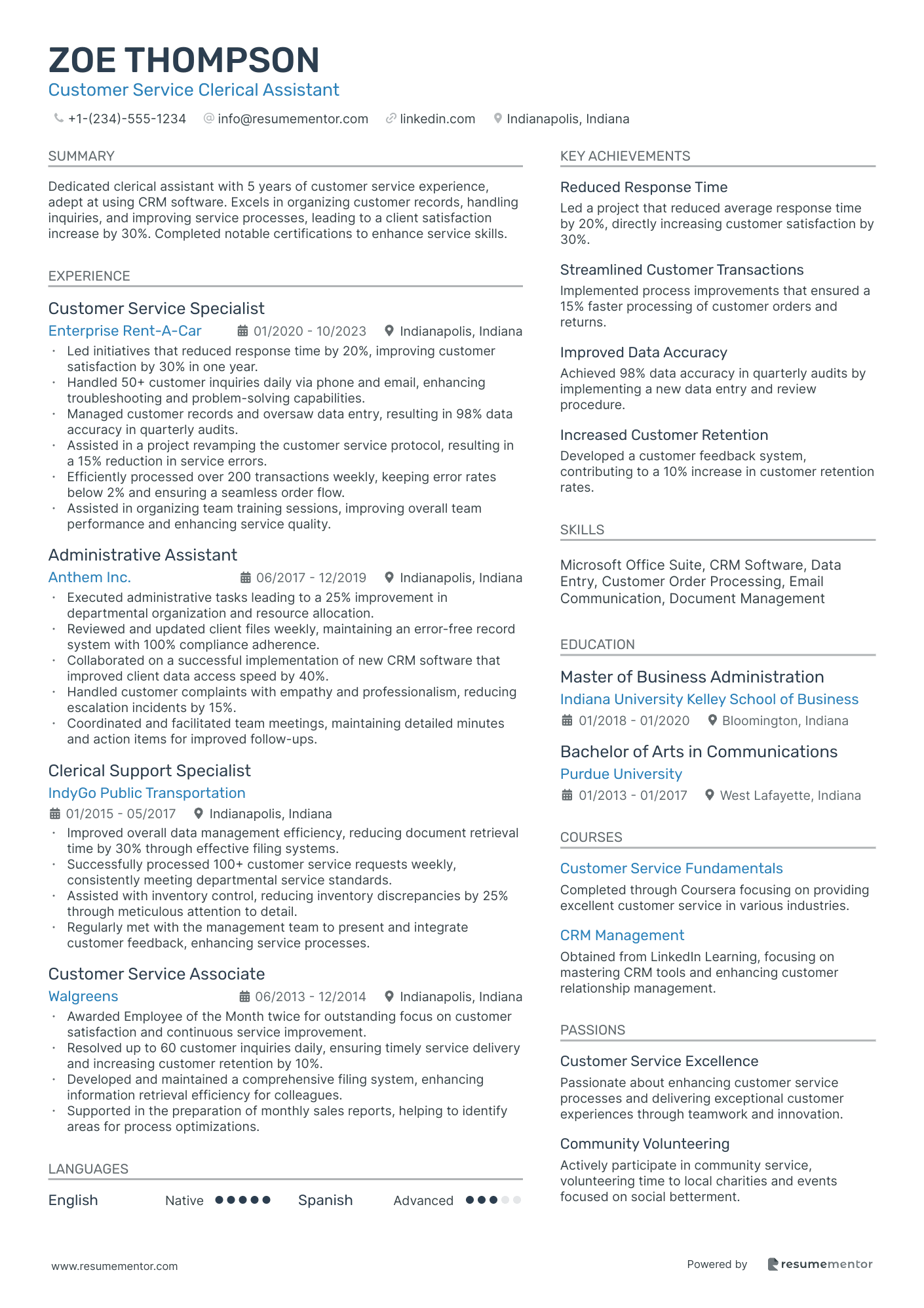
Customer Service Clerical Assistant
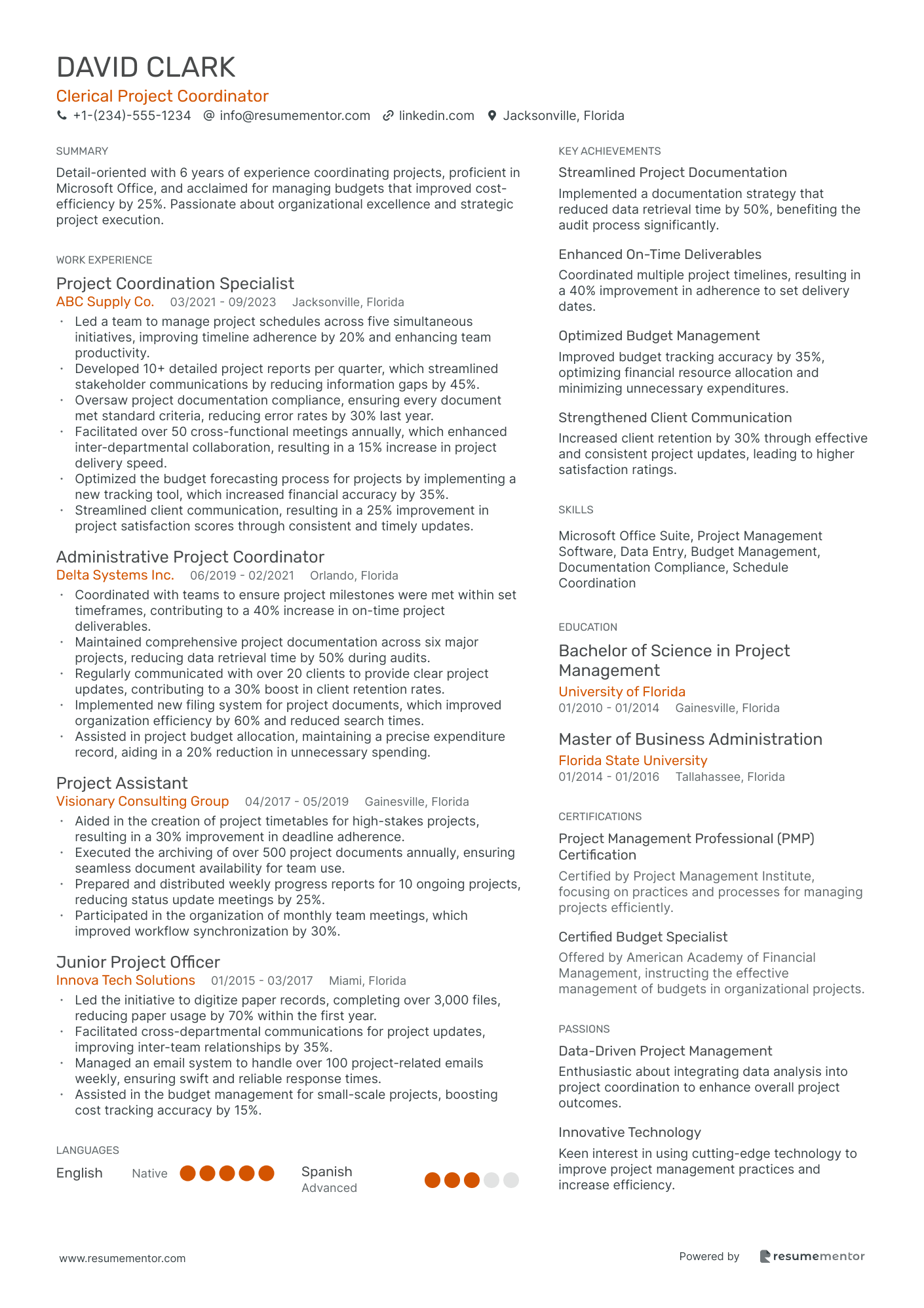
Clerical Project Coordinator
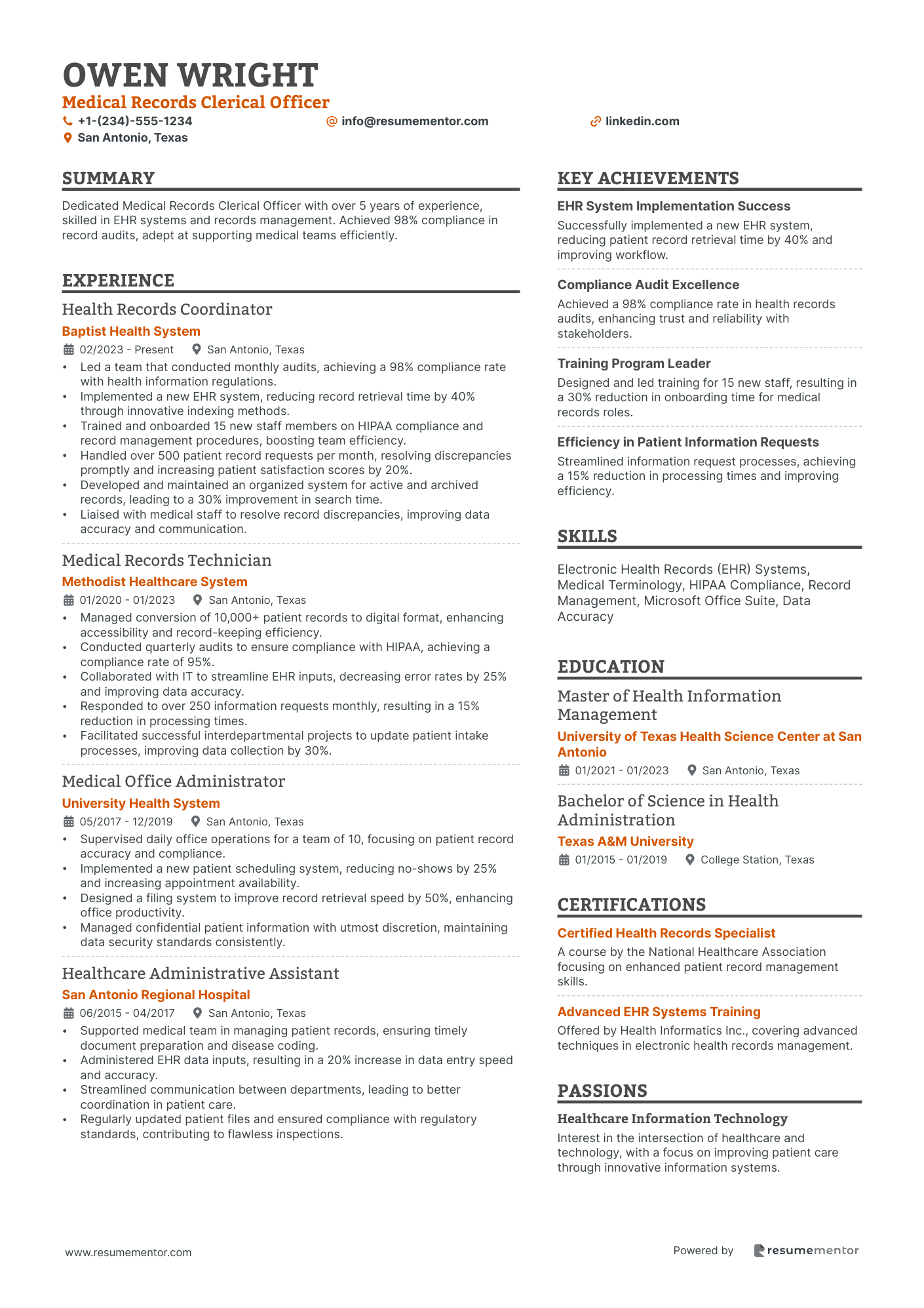
Medical Records Clerical Officer
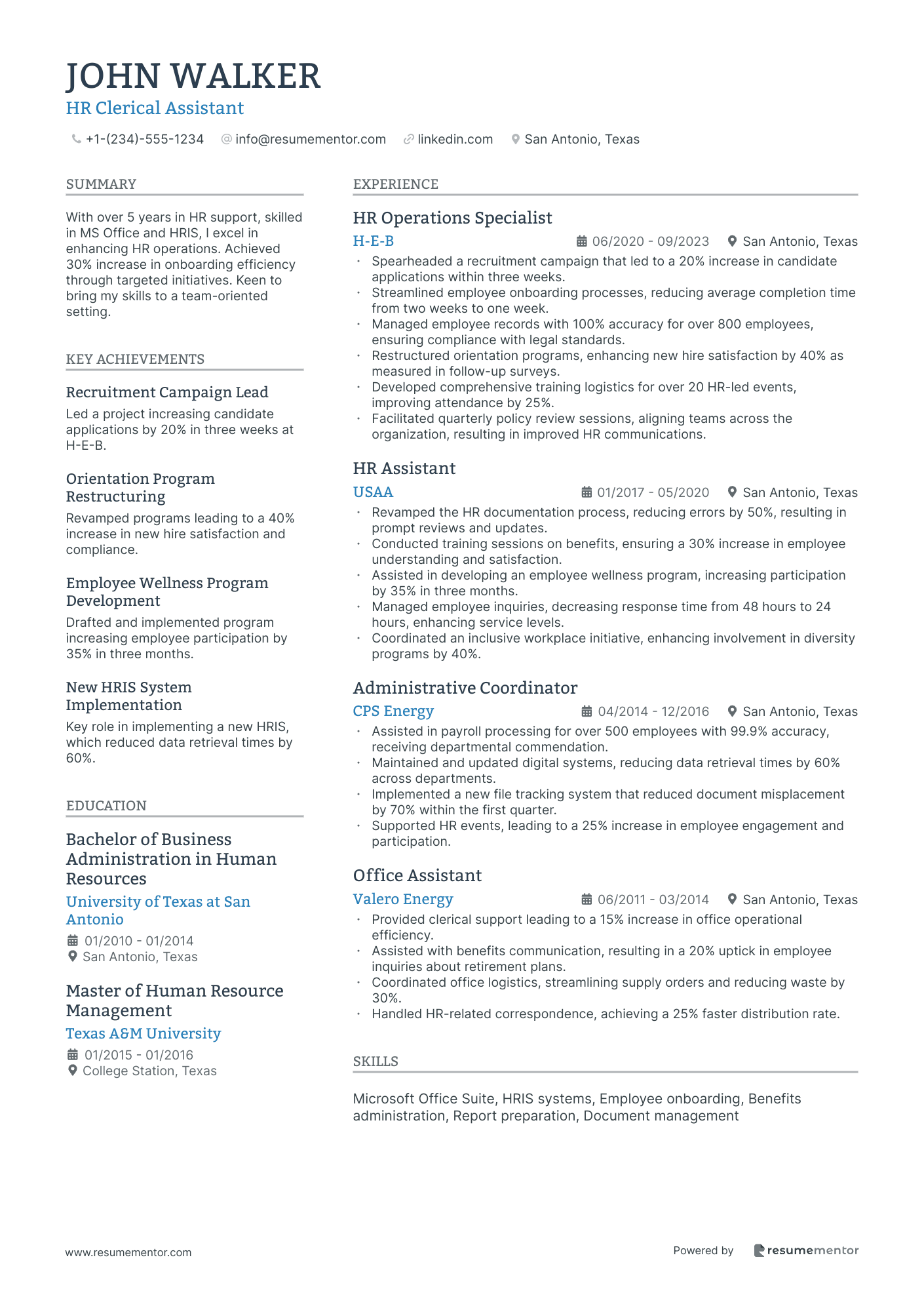
HR Clerical Assistant

Legal Doc Processing Clerk

Inventory Control Clerk resume sample
- •Led a team to implement a new inventory tracking software, reducing discrepancies by 35% in one year.
- •Developed and maintained reporting system that improved inventory management accuracy, resulting in a 15% efficiency boost.
- •Successfully coordinated quarterly inventory audits across multiple warehouses, achieving 98% audit accuracy.
- •Collaborated with purchasing department to forecast inventory needs, enhancing stock availability by 30%.
- •Trained over 20 new team members on best inventory practices, raising team productivity by 40%.
- •Developed a cross-departmental communication plan that improved forecast accuracy and reduced overstock incidents by 20%.
- •Implemented a real-time inventory tracking system that decreased stock discrepancies by 20%.
- •Managed inventory reports for management review, increasing decision-making speed by 25%.
- •Streamlined inventory processes, cutting product restocking time by 15%.
- •Analyzed sales trends to adjust inventory purchasing, reducing excess stock by 18%.
- •Assisted in vendor negotiations, saving the company 10% on annual inventory costs.
- •Facilitated efficient inventory restocking processes that increased turnaround time by 30%.
- •Liaised with warehouse staff, streamlining order fulfillment and decreasing shipping errors by 12%.
- •Developed inventory-related training materials, elevating staff competencies and reducing entry errors by 25%.
- •Executed logistics strategies that enhanced warehouse space utilization, freeing 5,000 square feet for new stock.
- •Monitored daily inventory levels to maintain adequate stock, decreasing out-of-stock instances by 10%.
- •Maintained accurate data entry in inventory management systems, leading to a 15% decrease in data errors.
- •Conducted monthly inventory counts, enhancing stock reporting accuracy by 20%.
- •Collaborated with the sales team to forecast demand accurately, reducing excess inventory by 12%.
Administrative Support Clerk resume sample
- •Implemented a new electronic filing system that decreased document retrieval time by 30%, enhancing efficiency in office operations.
- •Streamlined communication channels by organizing a centralized system for handling over 200 emails per day with 99% accuracy.
- •Led a special project to update and maintain a database of 5,000 client records, resulting in a 15% reduction in errors.
- •Assisted in the coordination of over 50 high-profile meetings annually, including venue selection and agenda preparation.
- •Monitored office supply levels closely, leading to a 20% reduction in unnecessary purchases and cost savings.
- •Collaborated with the finance department to process invoices, achieving a 10% improvement in accounts payable timelines.
- •Facilitated the onboarding process for 30 new employees, resulting in improved integration and training efficiency.
- •Developed comprehensive MS Excel spreadsheets that tracked departmental expenses, contributing to a 5% budget optimization.
- •Prepared professional presentation materials for executive meetings, enhancing the quality and impact of business presentations.
- •Managed the office calendar efficiently, scheduling over 100 meetings monthly with a 97% accuracy rate in booking.
- •Implemented a visitor management system that improved visitor check-in time by 25%, enhancing client satisfaction.
- •Assisted in planning and executing office events attended by over 200 employees, leading to increased team cohesion.
- •Maintained a 95% accuracy rate in data entry for critical company records using MS Excel and company-specific software.
- •Established a digital tracking system for maintenance requests, improving response time by 20% over six months.
- •Enhanced front desk operations by training new receptionists, reducing client wait time by 15%.
- •Coordinated logistics for a product launch event that attracted over 300 attendees, improving brand awareness and sales leads.
- •Supported internal communications by drafting and disseminating over 100 memos and communications monthly.
- •Tracked office supply inventory, reducing waste and cutting costs by 10% through efficient inventory management strategies.
- •Provided clerical support to a team of 10 managers, enhancing workflow efficiency through strategic support services.
Accounts Receivable Clerical Specialist resume sample
- •Managed over 500 invoices monthly, improving invoice processing time by 20%, ensuring timely and accurate billing.
- •Resolved discrepancies leading to a 15% decrease in billing errors, by cross-verifying documentation with a detailed approach.
- •Documented and maintained accounts receivable files, resulting in a significant improvement in audit compliance scores.
- •Collaborated with sales and customer service teams to streamline communication, reducing accounts-related queries by 30%.
- •Performed account reconciliations monthly, ensuring accurate reporting and consistent ledger maintenance across three major accounts.
- •Successfully implemented QuickBooks-driven automation, which enhanced daily cash receipt recordings by 25%.
- •Monitored and communicated payables status, resulting in a 10% reduction in overdue accounts through proactive follow-ups.
- •Reduced account delinquencies by 20% within a year, by implementing enhanced reporting mechanisms and strategic follow-ups.
- •Led a team in resolving outstanding billing issues, closing over 100 old disputed accounts effectively and efficiently.
- •Streamlined cash transaction entries to reduce processing errors, which resulted in a 30% improvement in accuracy.
- •Enhanced the aging reports preparation process, reducing compilation time by 15% through improved data analysis techniques.
- •Regularly liaised with senior managers to communicate the financial status, leading to informed decision-making and planning.
- •Successfully managed the transition to a new accounting system, facilitating over 25 training sessions to ensure team proficiency.
- •Developed a comprehensive filing system for over 2,000 records, significantly enhancing the retrievability and organization of documents.
- •Assisted in the month-end closing process by preparing all receivables reports, contributing to a smooth and timely closure.
- •Provided administrative support by coordinating numerous data entry projects, achieving a 95% accuracy rate.
- •Contributed to the implementation of a new financial dashboard, enhancing the visibility of critical metrics by 40%.
- •Coordinated with the accounts payable team to resolve discrepancies, which upgraded compliance with company policies considerably.
- •Analyzed and processed financial data resulting in higher accuracy in financial reporting submitted regularly to senior management.
- •Executed regular training sessions for junior staff, improving overall team capability and reducing document processing errors by 12%.
Clerical Data Entry Operator resume sample
- •Streamlined data entry processes, resulting in a 25% increase in processing speed and reduced error rates by 40%.
- •Collaborated with cross-functional teams to gather and validate data, enhancing data quality for key database systems.
- •Managed high-volume data entry tasks, averaging 5,000 records monthly for critical client projects.
- •Developed comprehensive data validation protocols that improved accuracy and compliance with industry standards.
- •Led a special project to digitize 10 years of archival hard copy data, achieving completion two months ahead of schedule.
- •Trained three new team members on data entry procedures, focusing on accuracy and efficiency improvements.
- •Ensured data integrity for over 15,000 entries monthly across multiple platforms, maintaining a 99% accuracy rate.
- •Implemented a new filing system for electronic and hard copy records, decreasing retrieval times by 30%.
- •Worked closely with IT to resolve data discrepancy issues, improving database reliability.
- •Coordinated the consolidation of data from legacy systems into modern databases, supporting company-wide integration initiatives.
- •Conducted monthly audits on data storage procedures, enhancing data protection and compliance.
- •Handled data entry and database maintenance to support business operations, surpassing accuracy benchmarks consistently.
- •Assisted in creating weekly data reports used for executive decision-making, boosting operational efficiency.
- •Led the implementation of an improved database system that decreased data retrieval times by 20%.
- •Participated in cross-departmental projects to streamline data exchange between teams, enhancing overall productivity.
- •Maintained data accuracy for over 20,000 entries monthly, achieving a record accuracy of 98.5%.
- •Identified and remedied data entry errors, contributing to a 10% reduction in discrepancies.
- •Collaborated with team members to optimize data entry procedures, enhancing workflow efficiency.
- •Supported the transition of physical documentation to a digital archive, resulting in a 60% reduction in storage requirements.
Bookkeeping and Clerical Specialist resume sample
- •Implemented new invoice processing system, improving accuracy by 20% and reducing processing time by 15 hours monthly.
- •Led month-end closing processes, ensuring all financial reports were accurate and completed within deadline.
- •Streamlined payroll processing system, saving 10% on administrative costs annually, benefiting both financial efficiency and employee satisfaction.
- •Developed financial summaries and budgets, providing management with insights that resulted in strategic cost-saving decisions.
- •Coordinated with IT to enhance accounting software, reducing system downtime by 25%, ensuring continuous operational efficiency.
- •Ensured compliance with relevant regulations, leading to zero compliance issues during external audits over two consecutive years.
- •Managed detailed reconciliation of accounts with zero discrepancies discovered during financial audits for three years.
- •Supervised a team of junior bookkeepers, increasing overall team productivity by 25% through effective training and mentoring.
- •Facilitated budget preparation efforts, instituting more accurate forecasting methods, leading to a 10% reduction in unnecessary expenditures.
- •Successfully negotiated new vendor payment terms, improving cash flow by extending payment cycles by 30 days on average.
- •Monitored and ensured adherence to accounting best practices, improving operational procedures and increasing department accuracy.
- •Oversaw accounts payable and receivable, ensuring timely payments and collections, reducing outstanding receivables by 20%.
- •Conducted thorough data entry and management of financial records, resulting in improved accuracy and reporting capabilities.
- •Assisted in year-end financial reporting and compliance efforts, aiding in successful completion of two annual audits.
- •Collaborated with procurement teams to effectively manage inventory levels, minimizing excess stock by 15%.
- •Performed clerical duties including filing and data entry, reducing file retrieval times by optimizing the filing system.
- •Accurately prepared payroll reports, enhancing prompt payroll distribution and reducing errors by implementing a new check system.
- •Maintained accurate inventory records, aiding in the procurement process and reducing overstock instances by 10%.
- •Provided administrative support to accounting teams, ensuring efficient daily operations and contributing to project completion.
Customer Service Clerical Assistant resume sample
- •Led initiatives that reduced response time by 20%, improving customer satisfaction by 30% in one year.
- •Handled 50+ customer inquiries daily via phone and email, enhancing troubleshooting and problem-solving capabilities.
- •Managed customer records and oversaw data entry, resulting in 98% data accuracy in quarterly audits.
- •Assisted in a project revamping the customer service protocol, resulting in a 15% reduction in service errors.
- •Efficiently processed over 200 transactions weekly, keeping error rates below 2% and ensuring a seamless order flow.
- •Assisted in organizing team training sessions, improving overall team performance and enhancing service quality.
- •Executed administrative tasks leading to a 25% improvement in departmental organization and resource allocation.
- •Reviewed and updated client files weekly, maintaining an error-free record system with 100% compliance adherence.
- •Collaborated on a successful implementation of new CRM software that improved client data access speed by 40%.
- •Handled customer complaints with empathy and professionalism, reducing escalation incidents by 15%.
- •Coordinated and facilitated team meetings, maintaining detailed minutes and action items for improved follow-ups.
- •Improved overall data management efficiency, reducing document retrieval time by 30% through effective filing systems.
- •Successfully processed 100+ customer service requests weekly, consistently meeting departmental service standards.
- •Assisted with inventory control, reducing inventory discrepancies by 25% through meticulous attention to detail.
- •Regularly met with the management team to present and integrate customer feedback, enhancing service processes.
- •Awarded Employee of the Month twice for outstanding focus on customer satisfaction and continuous service improvement.
- •Resolved up to 60 customer inquiries daily, ensuring timely service delivery and increasing customer retention by 10%.
- •Developed and maintained a comprehensive filing system, enhancing information retrieval efficiency for colleagues.
- •Supported in the preparation of monthly sales reports, helping to identify areas for process optimizations.
Clerical Project Coordinator resume sample
- •Led a team to manage project schedules across five simultaneous initiatives, improving timeline adherence by 20% and enhancing team productivity.
- •Developed 10+ detailed project reports per quarter, which streamlined stakeholder communications by reducing information gaps by 45%.
- •Oversaw project documentation compliance, ensuring every document met standard criteria, reducing error rates by 30% last year.
- •Facilitated over 50 cross-functional meetings annually, which enhanced inter-departmental collaboration, resulting in a 15% increase in project delivery speed.
- •Optimized the budget forecasting process for projects by implementing a new tracking tool, which increased financial accuracy by 35%.
- •Streamlined client communication, resulting in a 25% improvement in project satisfaction scores through consistent and timely updates.
- •Coordinated with teams to ensure project milestones were met within set timeframes, contributing to a 40% increase in on-time project deliverables.
- •Maintained comprehensive project documentation across six major projects, reducing data retrieval time by 50% during audits.
- •Regularly communicated with over 20 clients to provide clear project updates, contributing to a 30% boost in client retention rates.
- •Implemented new filing system for project documents, which improved organization efficiency by 60% and reduced search times.
- •Assisted in project budget allocation, maintaining a precise expenditure record, aiding in a 20% reduction in unnecessary spending.
- •Aided in the creation of project timetables for high-stakes projects, resulting in a 30% improvement in deadline adherence.
- •Executed the archiving of over 500 project documents annually, ensuring seamless document availability for team use.
- •Prepared and distributed weekly progress reports for 10 ongoing projects, reducing status update meetings by 25%.
- •Participated in the organization of monthly team meetings, which improved workflow synchronization by 30%.
- •Led the initiative to digitize paper records, completing over 3,000 files, reducing paper usage by 70% within the first year.
- •Facilitated cross-departmental communications for project updates, improving inter-team relationships by 35%.
- •Managed an email system to handle over 100 project-related emails weekly, ensuring swift and reliable response times.
- •Assisted in the budget management for small-scale projects, boosting cost tracking accuracy by 15%.
Medical Records Clerical Officer resume sample
- •Led a team that conducted monthly audits, achieving a 98% compliance rate with health information regulations.
- •Implemented a new EHR system, reducing record retrieval time by 40% through innovative indexing methods.
- •Trained and onboarded 15 new staff members on HIPAA compliance and record management procedures, boosting team efficiency.
- •Handled over 500 patient record requests per month, resolving discrepancies promptly and increasing patient satisfaction scores by 20%.
- •Developed and maintained an organized system for active and archived records, leading to a 30% improvement in search time.
- •Liaised with medical staff to resolve record discrepancies, improving data accuracy and communication.
- •Managed conversion of 10,000+ patient records to digital format, enhancing accessibility and record-keeping efficiency.
- •Conducted quarterly audits to ensure compliance with HIPAA, achieving a compliance rate of 95%.
- •Collaborated with IT to streamline EHR inputs, decreasing error rates by 25% and improving data accuracy.
- •Responded to over 250 information requests monthly, resulting in a 15% reduction in processing times.
- •Facilitated successful interdepartmental projects to update patient intake processes, improving data collection by 30%.
- •Supervised daily office operations for a team of 10, focusing on patient record accuracy and compliance.
- •Implemented a new patient scheduling system, reducing no-shows by 25% and increasing appointment availability.
- •Designed a filing system to improve record retrieval speed by 50%, enhancing office productivity.
- •Managed confidential patient information with utmost discretion, maintaining data security standards consistently.
- •Supported medical team in managing patient records, ensuring timely document preparation and disease coding.
- •Administered EHR data inputs, resulting in a 20% increase in data entry speed and accuracy.
- •Streamlined communication between departments, leading to better coordination in patient care.
- •Regularly updated patient files and ensured compliance with regulatory standards, contributing to flawless inspections.
HR Clerical Assistant resume sample
- •Spearheaded a recruitment campaign that led to a 20% increase in candidate applications within three weeks.
- •Streamlined employee onboarding processes, reducing average completion time from two weeks to one week.
- •Managed employee records with 100% accuracy for over 800 employees, ensuring compliance with legal standards.
- •Restructured orientation programs, enhancing new hire satisfaction by 40% as measured in follow-up surveys.
- •Developed comprehensive training logistics for over 20 HR-led events, improving attendance by 25%.
- •Facilitated quarterly policy review sessions, aligning teams across the organization, resulting in improved HR communications.
- •Revamped the HR documentation process, reducing errors by 50%, resulting in prompt reviews and updates.
- •Conducted training sessions on benefits, ensuring a 30% increase in employee understanding and satisfaction.
- •Assisted in developing an employee wellness program, increasing participation by 35% in three months.
- •Managed employee inquiries, decreasing response time from 48 hours to 24 hours, enhancing service levels.
- •Coordinated an inclusive workplace initiative, enhancing involvement in diversity programs by 40%.
- •Assisted in payroll processing for over 500 employees with 99.9% accuracy, receiving departmental commendation.
- •Maintained and updated digital systems, reducing data retrieval times by 60% across departments.
- •Implemented a new file tracking system that reduced document misplacement by 70% within the first quarter.
- •Supported HR events, leading to a 25% increase in employee engagement and participation.
- •Provided clerical support leading to a 15% increase in office operational efficiency.
- •Assisted with benefits communication, resulting in a 20% uptick in employee inquiries about retirement plans.
- •Coordinated office logistics, streamlining supply orders and reducing waste by 30%.
- •Handled HR-related correspondence, achieving a 25% faster distribution rate.
Legal Doc Processing Clerk resume sample
- •Managed and processed over 300 legal documents monthly, ensuring 98% accuracy rate in filings and submissions.
- •Collaborated with attorneys to streamline document preparation processes, resulting in a 20% increase in workflow efficiency.
- •Implemented a new electronic filing system that reduced processing times by 15% and improved accessibility for team members.
- •Assisted in training new team members on document management software, boosting team performance and understanding.
- •Facilitated communication between legal professionals and clients to ensure timely submission of necessary documentation.
- •Conducted regular audits to ensure compliance with court filing requirements, successfully maintaining a 100% compliance rate.
- •Assisted in organizing a comprehensive database of legal documents, improving retrieval times by 30%.
- •Performed detailed data entry tasks, processing over 200 legal documents per week with a 99% accuracy rate.
- •Liaised with court personnel to confirm filing requirements, effectively minimizing document rejection rates to below 2%.
- •Reviewed and edited legal documents for precision, contributing to the successful resolution of high-profile cases.
- •Supported attorneys in preparation of court documentation, enhancing team productivity and case management.
- •Coordinated filing of legal documents with state agencies, achieving a cost-saving rate of 15% in service fees.
- •Maintained confidentiality of legal documents, ensuring that sensitive information was handled with utmost care.
- •Utilized advanced Microsoft Office skills to draft and format legal documents, supporting efficient legal processes.
- •Provided administrative support for records management, enhancing the organization and security of legal files.
- •Supported legal team by preparing and processing legal documents, ensuring timely submission to relevant parties.
- •Managed electronic filing system, increasing document accessibility and effective time management within the office.
- •Communicated with clients to confirm details and resolved discrepancies, maintaining a high level of service quality.
- •Regularly updated case management software, assisting in the accurate tracking and maintenance of case status.
Crafting a clerical resume can feel like solving a puzzle without knowing what the final picture looks like. Your strong skills in managing files and organizing schedules are key pieces of this puzzle. However, translating these skills into a compelling resume can be a challenge.
These everyday tasks—multitasking, solving problems, and keeping things in order—are more than just duties; they represent your technical expertise. To make sure these strengths stand out, a well-structured resume is crucial. Using a reliable resume template can guide you in showcasing your achievements effectively. If you're unsure of where to start, have a look at these resume templates for inspiration.
Think of your resume as more than just a list of past jobs. It's a chance to tell your professional story and catch the attention of potential employers. Focus on highlighting what each role required and how you excelled, demonstrating the breadth of your experience. With a carefully crafted resume, you'll be well-prepared to land your next clerical role, where your skills can truly shine.
Key Takeaways
- Your resume should serve as a professional introduction, effectively showcasing your skills and experiences in a cohesive manner.
- Use a reverse-chronological format to highlight your most recent and relevant experiences for hiring managers.
- Quantify your achievements in clerical roles using measurable outcomes to emphasize your skills in improving processes and efficiency.
- Beside core sections like contact information, work experience, and education, consider adding extra sections like languages, hobbies, and volunteer work to enhance your resume.
- Properly crafted sections, like skills and certificates, can significantly boost your resume's appeal by clearly aligning your qualifications with job requirements.
What to focus on when writing your clerical resume
A clerical resume serves as your professional introduction, so it's important to craft it in a way that effectively showcases your skills and experiences. Every section should work together to paint a cohesive picture of your abilities and qualifications.
How to structure your clerical resume
- Contact Information — Start with your full name, phone number, and professional email. Ensure these elements are easy to access and error-free because they form the basis for all recruitment communication. Consistency here sets a professional tone right from the start.
- Objective Statement — This brief section offers a chance to align your career aspirations with the company's goals. Clearly articulate your objectives and how your specific skills in areas like "office management" or "administrative support" make you an ideal candidate for the role. This helps you stand out by directly addressing recruiters' needs.
- Work Experience — Detail your previous clerical or administrative roles with a focus on your responsibilities and accomplishments. Mention specific tasks such as "managed scheduling," "prepared reports," and "maintained filing systems." This section builds credibility by showcasing your concrete experience in handling tasks crucial to clerical jobs.
- Education — Your educational background should support your career path and demonstrate your preparedness for clerical duties. Include relevant courses and degrees, along with any certifications that highlight your capabilities in office management. This highlights your foundational knowledge, bridging your experience with your qualifications.
- Skills — Focus on specific abilities such as "proficiency in Microsoft Office," "data entry," and "document management." Tailor your skills to match the job description, establishing a direct connection between what you offer and what the company needs. This section should reaffirm the capabilities demonstrated in your work experience.
- Achievements — Highlight accomplishments that illustrate your efficiency and effectiveness, such as "reducing filing errors by 30%." Accomplishments not only validate your past roles but also serve as predictors of future success.
To complete your clerical resume, consider optional sections like "Volunteer Experience" or "Professional Affiliations," which can offer additional insights into your skills and dedication. In the sections below, we will explore each of these components more thoroughly to ensure your resume is as effective as possible.
Which resume format to choose
Crafting a standout clerical resume starts with selecting the right format. For this role, the reverse-chronological layout is your best bet. It organizes your work history and skills in a straightforward manner, which hiring managers prefer, as it highlights your most recent and relevant experience right away.
Choosing the right font can enhance this professional presentation. Modern and readable fonts like Montserrat, Lato, or Raleway offer a contemporary style without sacrificing clarity. Using these fonts demonstrates attention to detail and keeps your resume looking current.
File format plays a critical role in maintaining your resume's integrity. Saving your document as a PDF ensures that your formatting remains consistent, providing a reliable viewing experience on any device. It's a simple step that prevents potential mishaps in presentation.
Margins are another crucial aspect of resume design. Keeping them at one inch on all sides creates a clean look and ensures your resume doesn't appear cluttered. This thoughtful use of space allows your content to breathe and makes it easier for employers to digest the information at a glance.
Incorporating these elements will help you create a polished clerical resume that effectively presents your skills and experiences, making a positive impression on potential employers.
How to write a quantifiable resume experience section
A strong clerical experience section in your resume is crucial for making a memorable impression. It shows why you’re an ideal candidate by emphasizing past achievements that underline your clerical skills. You should organize your experience in reverse chronological order, starting with your most recent position. Aim to include jobs from the past 10-15 years, focusing on those most relevant to the role you’re pursuing. This approach ensures that your resume speaks directly to the job you want. Use job titles similar to the clerical position you’re applying for and customize your resume by highlighting experiences and skills that match the job ad. Selecting impactful action words like "managed," "coordinated," "executed," and "optimized" is essential to clearly convey your accomplishments.
Here’s a strong example of how your clerical experience section could look:
- •Managed scheduling and coordination for a team of 50+ employees, improving efficiency by 20%.
- •Streamlined data entry processes, reducing errors by 30% and saving 10 hours of weekly labor.
- •Implemented new filing system, resulting in a 25% reduction in document retrieval times.
- •Coordinated office supply procurement, cutting costs by 15% through strategic vendor selection.
This experience section effectively highlights your practical contributions through measurable successes. Each bullet point demonstrates a specific skill or responsibility, which collectively showcase your ability to enhance office management and administrative functions. These achievements indicate your proactive role in improving processes and reducing inefficiencies within the organization. By emphasizing quantifiable results, you create a vivid picture of your capabilities, highlighting your potential to bring similar enhancements to future roles. This alignment between your experience and the role’s requirements not only draws interest but also positions you as a candidate who can significantly contribute to the success of the company.
Problem-Solving Focused resume experience section
A clerical problem-solving-focused resume experience section should clearly showcase your ability to tackle challenges effectively in previous roles. Start by identifying specific tasks where your problem-solving skills made a significant impact, such as organizing a backlog of paperwork or improving office processes. Use action words to emphasize the proactive steps you took to address these issues. It's important to provide concrete examples that highlight the impact of your solutions, like saving time or better managing resources, to illustrate your contributions.
For each position, include the dates you worked, your job title, and the company name. Under each job listing, use bullet points to detail your key responsibilities and accomplishments, while focusing on your problem-solving successes. These bullet points should include measurable outcomes, such as cutting processing times or boosting accuracy, to make your effectiveness clear. Demonstrating how your efforts benefited the team or organization and mentioning any tools you used to achieve these results can further strengthen your resume.
Clerical Positions
XYZ Corporation
June 2020 - Present
- Improved filing system efficiency, reducing document retrieval time by 30%
- Implemented a tracking system for office supplies, cutting unnecessary costs by 15%
- Automated routine data entry tasks, freeing up 5 hours of staff time per week
- Designed a new scheduling process that increased meeting productivity
Project-Focused resume experience section
A project-focused clerical resume experience section should begin by zeroing in on projects that highlight your strengths in organization and administration. Start with a clear outline of your contributions and the positive outcomes they led to, ensuring your role is prominent in each project while keeping the description concise. Arrange your experiences in reverse chronological order, using bullet points for each role or project to capture your duties and achievements in a straightforward way.
Within each bullet point, use dynamic action verbs to bring your responsibilities to life and include measurable results to clearly demonstrate your impact. Tailor these aspects to align with the job description, focusing on the skills and qualifications that are most relevant to the position you want. By doing this, your resume becomes a standout, showcasing not only your capability in managing clerical tasks but also your effectiveness in contributing to team projects.
Clerical Project Coordinator
XYZ Corporation
June 2020 - Present
- Managed team schedules for 10 members, ensuring all deadlines were met consistently.
- Boosted efficiency by 30% with a new digital filing system for document storage.
- Enhanced stakeholder communication by preparing detailed project reports.
- Reduced scheduling conflicts by 20% by coordinating logistics for meetings.
Customer-Focused resume experience section
A customer-focused clerical resume experience section should clearly demonstrate how your organizational skills contribute to excellent customer service. Begin by highlighting experiences where you excelled in handling customer needs. Use clear and straightforward language to ensure everything flows smoothly. Emphasize the actions you took and the positive impact they had, illustrating instances where you enhanced customer interactions or helped your team improve service quality.
When detailing each job experience, include specifics like dates, job title, workplace, and major accomplishments. Ensure every bullet point underscores your commitment to prioritizing customer needs, resolving issues, or streamlining processes for a better customer experience. Highlight specific outcomes, such as the volume of calls managed or improvements in customer satisfaction, to make your resume truly stand out.
Administrative Assistant
Best Office Co.
June 2019 - August 2023
- Scheduled appointments and managed office communications, which improved response times by 30%.
- Handled customer inquiries over phone and email, leading to a 15% increase in customer satisfaction.
- Organized and maintained filing systems, saving team members 20 hours a month with faster document retrieval.
- Worked with the team to develop a feedback system, boosting service delivery by 25%.
Collaboration-Focused resume experience section
A collaboration-focused clerical resume experience section should demonstrate how your skills enhance team dynamics and achieve group goals. Begin by highlighting how you support team objectives, such as organizing meetings, coordinating office tasks, and facilitating projects. These experiences show your ability to improve communication and manage shared resources, which are crucial for successful collaboration. Your organizational expertise should shine through, showcasing how it boosts efficiency and aids in solving problems.
Incorporate clear, active language in the bullet points to outline specific contributions and achievements. Describe how you coordinated and led team briefings to maintain project alignment or managed calendars to ensure smooth scheduling. Highlight your role in enhancing communication across departments, whether by organizing information sessions or keeping contact directories up-to-date. By illustrating your role in tracking project progress and meeting deadlines, you emphasize your vital contribution to the team's success.
Administrative Support Specialist
Tech Solutions Corp.
June 2018 - Present
- Coordinated and led weekly team briefings to improve project alignment.
- Managed shared calendars for 15 team members ensuring smooth scheduling of meetings.
- Facilitated inter-departmental communication by organizing information sessions and maintaining updated contact directories.
- Supported collaborative projects by tracking progress and ensuring timely submission of deliverables.
Write your clerical resume summary section
A clerical-focused resume summary should clearly convey your skills and experiences in a way that grabs attention. Highlight the qualities that make you an asset to any office environment. Here’s an example of how to craft a succinct yet powerful summary:
This type of summary ties together your experience, skills, and advantages relevant to a clerical role. These highlights emphasize your organizational skills, multitasking abilities, and tech savvy, all of which are critical in such roles.
When considering the structure, remember that a resume summary is different from a resume objective. A summary focuses on what you bring to a position based on past achievements, which is ideal if you have relevant experience. In contrast, a resume objective is better suited for those just starting out, offering insight into your career goals. Meanwhile, a resume profile might highlight your personal traits, and a summary of qualifications usually presents a list of your best skills and achievements. By choosing the right approach, you can tailor your resume to your strengths and what potential employers are looking for.
Listing your clerical skills on your resume
A clerical-focused resume should effectively highlight your skills to make a strong impression. You can choose to list your skills in a dedicated section or seamlessly incorporate them into your experience or summary to showcase your expertise. Demonstrating your strengths and soft skills offers employers insight into your character and work ethic. Hard skills, on the other hand, reflect specific abilities you've learned through training or experience, which are critical for performing essential job tasks. These skills and strengths not only capture the attention of hiring managers but also enhance the chances of your resume passing through applicant tracking systems.
Here's an example of a standalone skills section crafted for a clerical role:
This skills section is effective as it highlights competencies essential to clerical work, painting a picture of your capabilities. Skills like organization, attention to detail, and time management showcase a worker who is diligent and detail-oriented. By listing tools like Microsoft Office Suite, you demonstrate your proficiency with key software, which can make you a valuable asset to any team.
Best hard skills to feature on your clerical resume
For clerical roles, hard skills are vital as they demonstrate your technical expertise and efficiency in managing office functions. They communicate your ability to handle the tools and software that are crucial for the job.
Hard Skills
- Microsoft Office proficiency
- Data entry
- Filing and data management
- Calendar and schedule management
- Email management
- Basic bookkeeping
- Document preparation
- Office equipment operation
- Customer relationship management (CRM) software
- Report generation
- Meeting coordination
- Supply management
- Record keeping
- Typing speed and accuracy
- Understanding of office procedures
Best soft skills to feature on your clerical resume
Soft skills are equally important for a clerical role as they highlight your interpersonal and organizational strengths. They reflect your ability to interact effectively with others and manage various office activities smoothly.
Soft Skills
- Communication
- Organization
- Time management
- Problem-solving
- Adaptability
- Attention to detail
- Customer service orientation
- Teamwork
- Multitasking
- Dependability
- Initiative
- Patience
- Active listening
- Stress management
- Professionalism
How to include your education on your resume
An education section is an important part of your clerical resume. It shows your qualifications and helps employers see if you're right for the job. Tailor this section to the position you're aiming for. Only include relevant educational info. Leave out anything unrelated. When listing a degree, be clear and direct about what you studied. If your GPA is 3.5 or above, consider including it to highlight your academic achievement. Mention honors like cum laude to show your commitment and success.
Here’s a wrong and right example of a standalone education section:
- •Graduated cum laude
The second example is solid because it focuses on an education relevant to a clerical role. It lists a degree specifically related to office skills. High GPA and honors like "cum laude" showcase dedication and ability. Each part adds value, clearly aligning with job requirements.
How to include clerical certificates on your resume
Incorporating a certificates section into your clerical resume is crucial as it showcases your qualifications and expertise. List the certificate's name to provide clarity on your skills. Include the date of completion to demonstrate the recency of your knowledge. Add the issuing organization to lend credibility to your qualifications. Certificates can sometimes be included in the header for immediate visibility, such as "John Doe, Certified Administrative Professional."
A well-crafted certificates section enhances your resume's appeal. Here is an example:
This example is effective because it includes certifications that directly relate to clerical work. The Certified Administrative Professional certification demonstrates advanced skills in office management, which is essential for clerical roles. The Microsoft Office Specialist certification shows proficiency in software tools frequently used in office settings. Mentioning reputable issuers such as the IAAP and Microsoft adds legitimacy. Including this section in your resume can significantly boost your chances of standing out to employers.
Extra sections to include on your clerical resume
Preparing a resume for a clerical position involves more than just listing your work history. Adding sections like languages, hobbies, volunteer work, and books can enhance your resume and make you stand out.
- Language section — Highlight language skills to show your ability to communicate across different cultures, which is valuable in a diverse workplace.
- Hobbies and interests section — Include hobbies to showcase soft skills and personality traits that are relevant to office work such as attention to detail or teamwork.
- Volunteer work section — Display volunteer experiences to highlight your commitment to community service and demonstrate skills like leadership and organization.
- Books section — Mentioning books you have read can reflect your eagerness for learning and provide insights into your interests that align with clerical duties.
Integrating these sections adds depth to a clerical resume. This approach paints a fuller picture of who you are beyond your job history. It also helps potential employers see you as a well-rounded candidate. Including these details can make your resume more memorable and engaging.
In Conclusion
In conclusion, creating a strong clerical resume is like telling a story about you. This story highlights your technical skills and experiences that are vital to potential employers. Start by organizing your work history and skills clearly, which helps hiring managers see your most important qualities quickly. Use a reverse-chronological layout and select clear, modern fonts for readability. Consistent formatting also ensures your resume looks polished across different devices.
Your clerical resume should include sections for contact information, an objective statement, work experience, education, skills, and achievements. Consider adding optional sections like volunteer work, hobbies, or professional affiliations to give depth to your resume. This approach helps you stand out as a well-rounded candidate. Emphasize measurable achievements in your past roles to show your effectiveness in improving processes and reducing inefficiencies.
Choosing appropriate hard and soft skills to list on your resume is essential. This mix of technical and interpersonal skills showcases how you can contribute positively to an office environment. Highlight any certifications or special training relevant to clerical roles to further boost your credibility.
Lastly, remember to tailor your resume for each job application by aligning it with the job description. Highlight experiences and skills that match the job requirements. This approach enhances your chances of catching the attention of hiring managers. With attention to detail and thoughtful organization, your clerical resume can become a powerful tool in your job search.
Related Articles
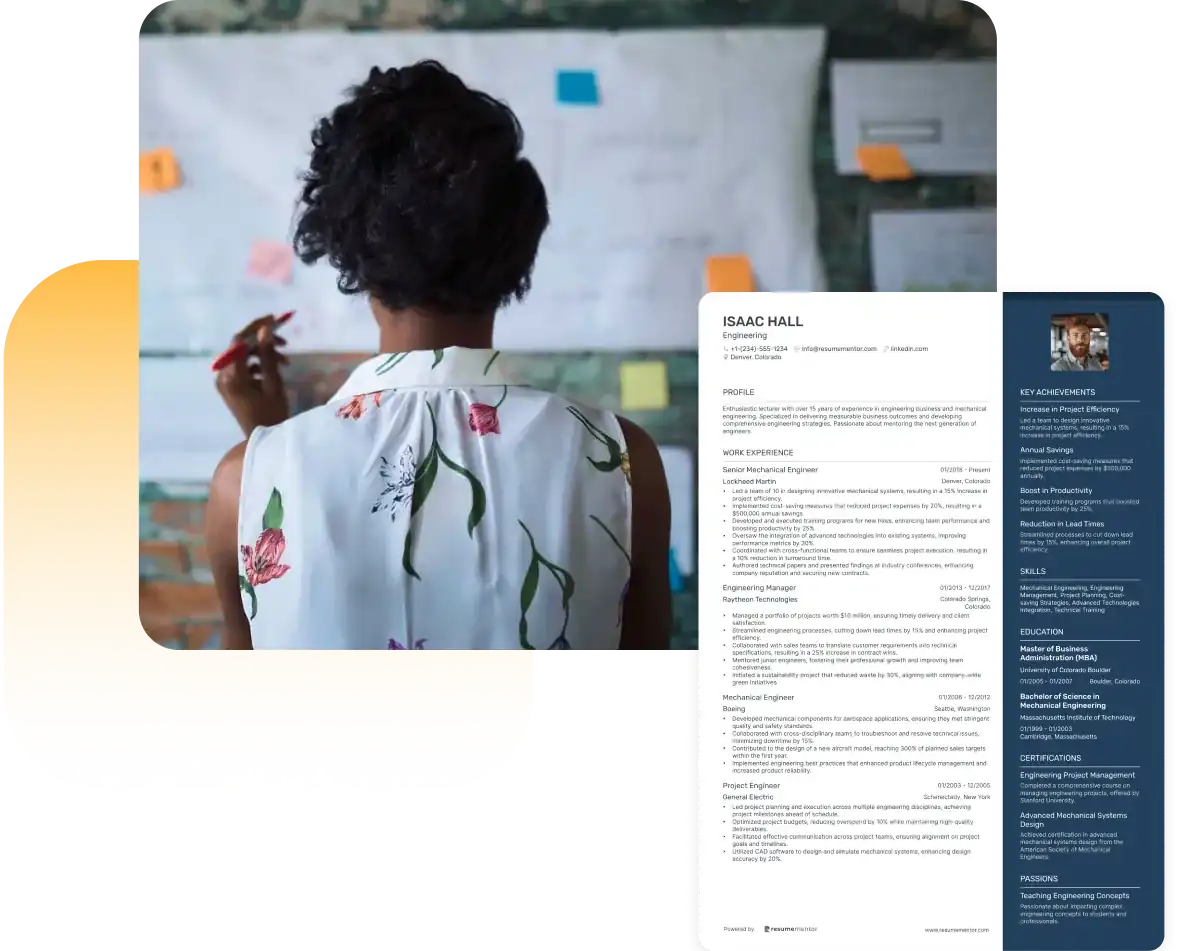
Continue Reading
Check more recommended readings to get the job of your dreams.
Resume
Resources
Tools
© 2025. All rights reserved.
Made with love by people who care.

